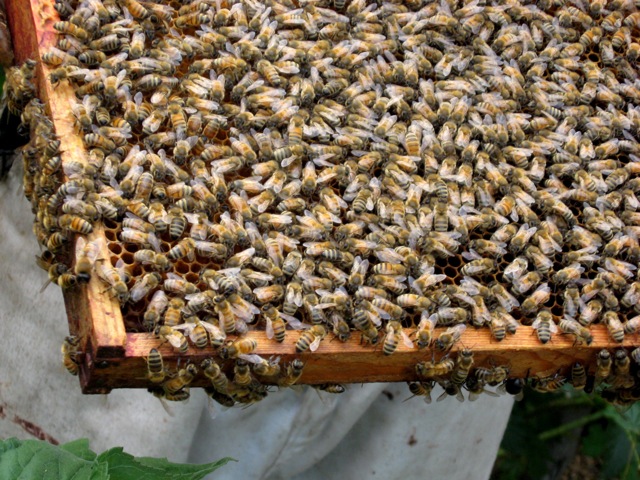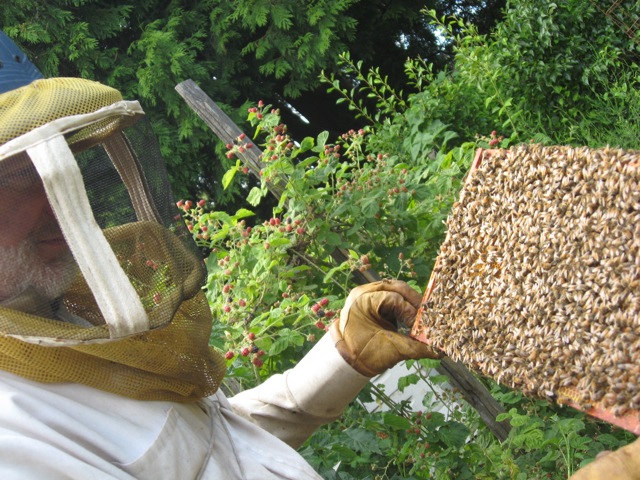
reference-image, l
(article, Miriam Wolf)
[%pageBreakSettings nobreak=true] Have you heard the buzz? In cities around the country, you can't help but notice it: the industrious hum of honey bees. These bees aren't feral bees, making honey from the dregs of soda cans and dandelion pollen. Instead, they’re carefully managed colonies, tended by urban dwellers motivated by a variety of desires: saving the endangered honey bee, encouraging the growth of lush, healthy gardens, and of course, harvesting and eating sweet, sticky, home-grown honey. Like chicken keeping and edible landscaping, urban beekeeping is on the rise. In May, the Wall Street Journal noted that beekeeping is surging nationwide, and municipal codes are changing to follow suit. The paper followed up in June with an article about the beehives at the White House. And the August issue of Bon Appétit magazine recounted Nathalie Jordi's efforts to keep bees and harvest honey on a Manhattan rooftop. [[block(sidebar). h1.Featured recipes]] According to Steve Cohen, who manages food policy and programs for the city of Portland, Oregon, there are many advantages to having your own hive. “The obvious benefits are pollination for neighborhood gardens, helping keep the bee population healthy, and great-tasting honey,” he notes. “However, I think the best benefit is putting people in touch with the natural world and providing urban dwellers with a primary connection to their food source. This is key to changing attitudes about food.” And Cohen doesn’t just talk the talk; he has a backyard hive of his own. In northeast Portland, Glen Andresen’s back yard is a paradise of grapes, berries, sugar snap peas, tomatoes — and more than a dozen hives of honey bees to pollinate it all. Andresen has been teaching classes in organic beekeeping for the last four years. He concurs that beekeeping seems to be getting more popular in Portland. “Last summer was my strongest year,” he says. “I had 120 students come through my classes.” This year, he’s on track to match that number. [%image reference-image float=right width=400 caption="A hive frame covered in honey bees."] Laura Dalton, a shop technician in the art department at Portland's Reed College, is one of the new wave of hobbyist beekeepers. She started keeping bees as an offshoot of her interest in gardening. “About four years ago, when the whole colony-collapse thing was in the news, I noticed that there were no honey bees in my back yard, and I decided I wanted to do something about it,” she says. Now she manages several hives. She notes that beekeeping requires commitment and responsibility, especially because of diseases that can migrate to other colonies. But she finds bees fascinating to observe, and adds, “Honey fresh out of the hive tastes like nothing you've ever had out of a jar.” Starting a beehive isn’t like dumping a goldfish into a bowl; the learning curve can be daunting. “Find a mentor,” says Dalton. “Handle someone else's bees before you get your own.” At Ruhl Bee Supply in Gladstone, Oregon, employee Brandy Rogers says that beekeeping is just like any other endeavor: you get out of it what you put into it. “If you're going to invest in it and learn what you need to, you'll be successful,” she says. h3. A beekeeping primer The first decision to make — apart from whether you want to commit to honey bees in the spring, the typical starting season for beekeeping — is what kind of hive you want to house your honey bees. Langstroth hives are the standard beekeeping hive. Basically a box with frames that bees build the honeycomb into, Langstroth hives are, according to Andresen, the most efficient for honey production. But many beekeepers are turning to top-bar hives. In a top-bar hive, the bees hang the wax comb off a bar, instead of filling a frame. Top-bar and other foundationless hives produce less honey, but they are simpler and can be built yourself with salvaged materials. And, according to Dalton, foundationless hives are a more natural way to raise bees, as the bees can be inspected with less disturbance to their daily routine. Outfitting yourself as a beekeeper will cost around $375, says Andresen. That includes a Langstroth hive, protective wear, and other gear you’ll probably need, such as smokers and hive tools. Don't expect to harvest honey in the first year, as it takes eight times the resources to build up the wax comb as it does to produce honey. Do expect to lose a significant portion of your colonies over the winter to disease or parasites. That $375 figure doesn’t include the honey bees themselves, which can be ordered through the mail or acquired from a local swarm catcher. Swarm catchers — including Dalton — gather up colonies that have split off from existing colonies. Bees in a too-crowded hive will produce a new queen, then gorge on honey. When they've had their fill, half of the colony will swarm out of the hive with the new queen and land in a clump nearby. (When I visited Andresen, there was a monster swarm of 30,000 bees hanging in a nearby tree. It looked like a country ham.) Scouts then go out looking for a new home for the swarm. Before the swarm can move on, a swarm catcher will carefully collect it and either return the bees to the original beekeeper or pass them on to another beekeeper. [%image andresen float=left width=400 caption="Beekeeper Glen Andresen with a frame of his honey bees."] Once you've decided to get a colony or two of bees, your next step is to check in with your neighbors. In Portland, for example, the Multnomah County Health Department issues $12 permits that last indefinitely. To get a permit, you have to get signed permission petitions from any neighbors living within 150 feet of your proposed hives. Dave Thomson, a code enforcement officer with the health department, puts a positive spin on the petition requirement: “It provides the beekeeper with an opportunity to inform and educate \[people about\] the value of neighborhood bees, but also is an added protection against potential liability. Many neighbors react adversely if surprised to find out that 'thousands of stinging insects are next door,' but if properly informed, they usually welcome friendly neighborhood pollinators.” Other requirements include obscuring the location of the bees from public view and setting the hives at least 25 feet from public sidewalks and roads. An adequate source of water needs to be near the hives. In addition, it's a good idea to have a hedge or fence near the hives, so that when the bees swarm, they will fly up, not straight out into the path of pedestrians or cars. Speaking of thousands of stinging insects, Andresen points out the obvious: “You want to make sure you don't have any allergies to bee stings, because you will get stung.” During the last beekeeping class he taught through Portland Community College, he brought the class to his apiary to work with the bees. Right away, people got stung. “Chickens are looking better all the time,” Andresen noted wryly. But Andresen stresses that the more you work with bees, the more you understand their behavior and the more predictable they become — and the less you get stung. He hasn't lit his smoker, he notes, in at least six years, and he rarely gets stung. “I will keep bees for as long as I'm able, because they’re so interesting,” he says. “The relationship they have with flowering plants fascinates me.” And, of course, their honey is delicious. If you have Langstroth beehives, harvesting the sweet, golden nectar is a matter of smoking the bees so that they gorge on honey until they are docile, then removing the honey-laden frames. Make sure the honey in the frames is mature and and does not have any larvae in the comb. Then carefully brush off any bees that may be walking around on the frames. There are two ways to separate the honey from the comb. You can use an uncapping knife to scrape the wax off the honeycomb before placing the frame into an extractor, where it's whirled around until the honey is separated from the comb. A more low-tech way to get to your honey is to slice the honey-laden comb out of the frame, then crush the honey and comb together and place it into a bucket that's lined with a filter and equipped with a spigot at the bottom called a "honey gate." Time and gravity will then do the extracting for you. After that? All you have to do is enjoy the gooey results of your labors. p(bio). Miriam Wolf writes about books and food for various publications. She lives in Portland, Oregon.

reference-image, l

andresen, l